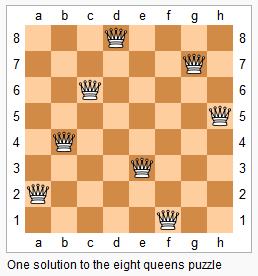51. N-Queens
Difficulty: Hard
Topics: Backtracking
Similar Questions:
Problem:
The n-queens puzzle is the problem of placing n queens on an n×n chessboard such that no two queens attack each other.

Given an integer n, return all distinct solutions to the n-queens puzzle.
Each solution contains a distinct board configuration of the n-queens' placement, where 'Q' and '.' both indicate a queen and an empty space respectively.
Example:
Input: 4 Output: [ [".Q..", // Solution 1 "...Q", "Q...", "..Q."], ["..Q.", // Solution 2 "Q...", "...Q", ".Q.."] ] Explanation: There exist two distinct solutions to the 4-queens puzzle as shown above.
Solutions:
class Solution {
public:
vector<vector<string>> solveNQueens(int n) {
vector<vector<string>> ret;
vector<int> path;
vector<bool> colVisited (n, false);
helper(n, 0, path, colVisited, ret);
return ret;
}
vector<string> generateSolution(vector<int>& path) {
int n = path.size();
string row = string(n, '.');
vector<string> solution;
for (int i = 0; i < n; ++i) {
solution.push_back(row);
solution.back()[path[i]] = 'Q';
}
return solution;
}
bool diagonal(int row, int col, vector<int>& path) {
int n = path.size();
for (int i = 0; i < n; ++i) {
if (abs(row - i) == abs(col - path[i])) return true;
}
return false;
}
void helper(int n, int pos, vector<int>& path, vector<bool>& colVisited, vector<vector<string>>& ret) {
if (n == pos) {
ret.push_back(generateSolution(path));
return;
}
for (int i = 0; i < n; ++i) {
if (colVisited[i] || diagonal(pos, i, path)) continue;
path.push_back(i);
colVisited[i] = true;
helper(n, pos + 1, path, colVisited, ret);
colVisited[i] = false;
path.pop_back();
}
}
};